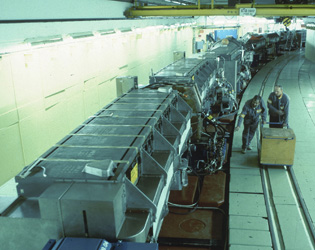Special relativity / Elementary Tour part 3: The relativity of space and time
One of the most surprising features of special relativity is that a number of statements and results which we usually think to be absolute turn out to be observer-dependent. In particular, statements about space and time, distances and duration turn out to be relative.
For example, in Einstein’s theory, simultaneity is a relative concept. Imagine that there are two events which an observer in space station A judges to be simultaneous – say, the explosion of a firecracker at one point in space and an alarm clock going off a few miles away. For an observer in space station B, which is moving relative to A, this statement will not necessarily be true: In general, such an observer will come to the conclusion that one of the events happened earlier than the other. (More about this unfamiliar state of affairs and about the necessity to first of all define simultaneity can be found in our Spotlight topic The definition of “now”.)
Similarly, temporal duration depends on the observer. This relativistic effect is called time dilation. Summarized briefly: Moving clocks are slower than stationary ones. A bit more precisely: An observer on station A measures time using his on-board clock. Station B, passing A at high speed, has an exact copy of A’s clock on board. Yet, from the point of view of A, the clock in station B runs more slowly than his own. A down-to-earth version of this effect can be tested with the help of elementary particles such as those particles accelerated inside the “proton synchrotron” of the European research centre CERN. A segment of this particle accelerator can be seen in the following photograph:

Particle accelerator © CERN
Many kinds of elementary particles are unstable. After some time has passed, they decay into certain other elementary particles. The average time until decay is called the particle’s life-time. When particles of the same kind that are either at rest or speeding around in a particle accelerator are compared, it turns out that the life-time of unstable particles at rest is significantly shorter. Experiments of this kind are in excellent agreement with the predictions of special relativity – from the point of view of an external observer, the “inner clock” of such particles slows down when such particles are accelerated to high speeds. Correspondingly, on average, they can take much longer to decay than particles at rest.
Time dilation has a counterpart in space called length contraction. From the point of view of an observer in space station A, who measures lengths using his own measuring rod, an exact copy of that same measuring rod whizzing by on-board space station B appears to be shortened.










